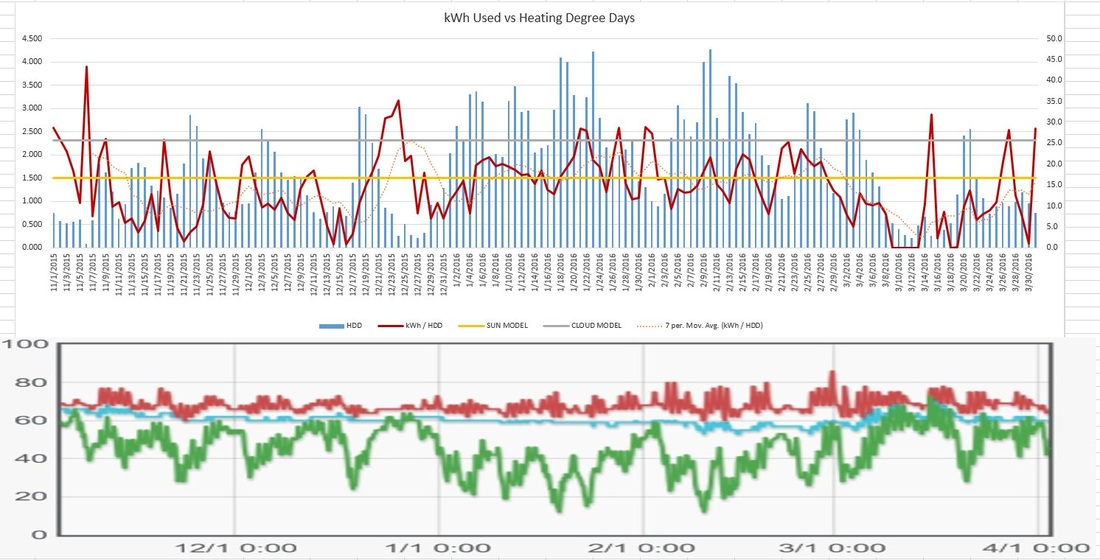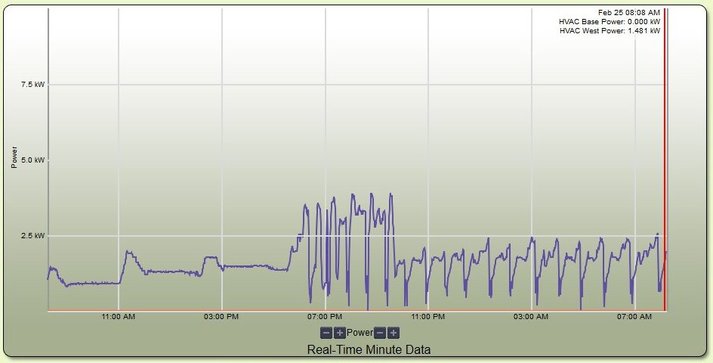February Report
The February temperatures came in at an almost perfect average of 747 Heating Degree Days (HDD) while March was pretty mild at only 388 HDD (about 75% of the 13 year average).
As I mentioned in the last report, the house performed very close to what was predicted by the computer model and averaged 1.656 kWh/HDD in January. While this was very close to the model, I was disappointed because November and December were so much better. I speculated that part of the difference was due to heating the basement during January.
In February we turned the basement heat off to see how that would effect the overall efficiency. I was surprised that the efficiency in February was 1.528 which is almost exactly as predicted by the model. Clearly, heating the basement has much less effect than I speculated in January.
At this point I must conclude that the exceptional performance in November and December was primarily due to greater efficiency of the Daikin heat pumps at warmer temperatures. I improve the computer model to use a better estimate of efficiency based on the average monthly temperatures.
March Report
March was only 388 HDD and also benefited from a lot of sun. We used only 341 kWh for heating (about $30.00) for an amazing efficiency of 0.879 kWh/HDD. This is almost twice as good as January.
2015 Heating Season
Though we will certainly use some heat through April, it will be minimal and I'm going to wrap up the heating season reporting now. The following chart shows the performance of the house from November 2015 through the end of March 2016.
The upper graph shows efficiency (red line) versus HDD (blue bars) while the lower graph shows the temperature of the first floor slab (red), the basement slab (blue) and the outside (green). The first floor slab temperature provides an indication of sunny days (spikes) versus cloudy days (flat).
The upper gray bar is the computer model prediction for how the house should perform on cloudy days with no solar gain. There are seven instances where the house under-performed. I only have an explanation for two of these occurrences which is described in the next section.
Issues with Mini-Splits
Overall, the Diakin mini-splits perform better than expected and average efficiency is better than 200%. However, we do experience climate conditions here that can make the heat pumps perform poorly.
This area is a borderline temperate rain-forest. There are many days where we are literally in the clouds and the humidity is at or near 100%.
Heat pumps extract heat from the environment so the exhaust temperature is several degrees lower than the outdoor ambient temperature. If the outdoor temperature is near freezing or below freezing then ice will build up on the coils of the heat pump. The units are designed to handle this and will automatically perform a defrost cycle when the outside condenser becomes clogged with frost/ice.
The following plot from the Energy Monitor illustrates what happens when there is a lot of moisture in the air and the outside temperature approaches freezing.
Prior to 6:00 PM the Mini-split was running continuously and was heating the space with no difficulty. As the exterior temperature dropped below 40 degrees the unit began to go though periodic defrost cycles. These can be seen as spikes in energy consumption followed by a short shut-down. During these periods, no heat is being delivered into the house. Fortunately (actually by plan.... not luck) we have enough reserve capacity that the house never got cold.
This is not a flaw in the mini-split system but there are a couple of lessons to be learned.
First, we fortunately went with three smaller 3-head units rather than one giant 8-head unit. This was slightly more expensive but has proven to be a wise choice. If we had one giant unit then the entire house would be shut down during the defrost cycle. With three smaller units, there was always at least one unit running when the others were going through defrost,
The other observation is that mini-splits will probably perform even better in arid environments where there is less moisture in the air to cause frost build up. I would not hesitate to recommend mini-splits in New Mexico, Arizona or southern Colorado, for example.
Conclusions
Overall, for the entire 5 months we consumed 3910 kWh for heating and had 2886 HDD during the period. This comes to an average of 1.355 kWh per HDD which is in line with the computer model. Of course, this was a mild winter so future heating seasons will probably be higher and more expensive.
Over this 5 month heating season we spent approximately $380.00 on heating. If I add October, the total comes to about $400.00. This is a dramatic improvement over Chicago where we spent an average of $1200.00 per year to heat a house of similar size. Yes, the climate in Chicago is 50% colder, but the cost of electricity is about 400% greater than natural gas.
This demonstrates that passive solar design, tight construction and high efficiency heat pumps can make an all-electric house practical and economical.



 RSS Feed
RSS Feed